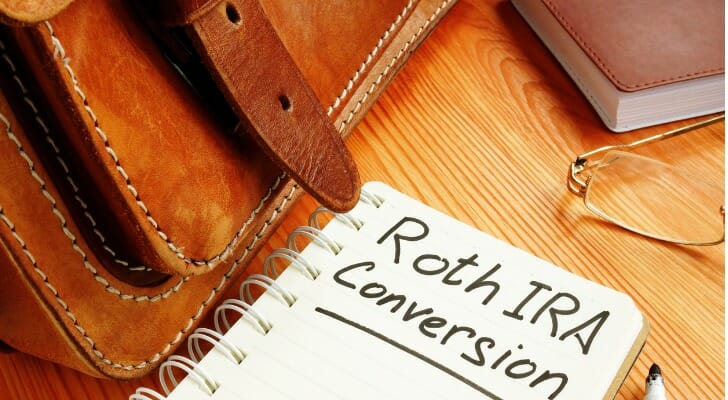Thinking of converting your traditional IRA to a Roth IRA? There are several reasons this might make sense. While you’ll have to pay income tax on the converted amount, qualified withdrawals from Roth IRAs are tax-free, meaning you won’t pay tax on your investment gains. That’s especially appealing to retirement savers who think they’ll pay a higher income tax rate in retirement than they do now. And if you make too much money to contribute directly to a Roth IRA, a conversion allows you to sidestep those income limits (a process known as a backdoor IRA). Whatever your reason, here’s what you need to know about converting to a Roth IRA.
Consider working with a financial advisor as you work on your retirement savings plan.
What Is a Roth IRA?
Let’s review the difference between a traditional IRA and a Roth IRA. A Roth IRA is funded with after-tax money. You don’t get to deduct your contributions to a Roth. The good news, though, is that when you take distributions from your Roth IRA in retirement you don’t owe taxes on that money. In exchange for paying taxes on your contributions up front, you get to enjoy tax-free growth and income in retirement.
A traditional IRA, on the other hand, front-loads the tax benefits. Traditional IRAs, like 401(k)s, are tax-deferred. You deduct your contributions to a traditional IRA, so every dollar you contribute reduces your taxable income. Then, in retirement, you have to pay taxes on the distributions you take.
Think your tax bracket will be higher in retirement than it is now? You may be better off with a Roth IRA. That way, you can pay lower taxes on the contributions you make now and you’ll dodge a higher tax bill in retirement.
If you think you’ll be in a lower tax bracket in retirement than the one you’re in now you may prefer to go with a traditional IRA. Of course, it’s hard to predict your tax bracket in retirement, especially if you’re in your 20s or 30s now. A lot could happen between now and your retirement, both in terms of your own income sources and in terms of tax policy.
Why Convert to a Roth IRA?

There are some serious benefits to converting to a Roth IRA. The main benefit is that your withdrawals are tax-free. If you already have a 401(k) or a taxable investment account, you’re going to face some taxes in retirement. Converting to a Roth IRA can give you a tax-free retirement income source to balance out those other accounts.
Another reason Roth IRA conversion is popular is that you don’t have to take required minimum distributions (RMDs). Traditional IRAs have IRS-mandated RMDs that kick in when you reach age 73 (75 for people born in 1960 or later). Roth IRAs, however, can grow and grow with no withdrawals necessary. This helps you manage your tax liability, and it means that if you want to let your Roth IRA grow as a source of tax-free income for your heirs, you can do so.
For high-income folks, converting to a Roth IRA gives you the tax benefits you otherwise wouldn’t be able to access due to income caps on Roth IRAs. If your income is high enough to render you ineligible to contribute to a Roth, converting is a good work-around. This is known as the “backdoor Roth” conversion process.
High earners can contribute to a traditional IRA and then convert it to a Roth IRA, no questions asked. There are no income limits on a Roth IRA conversion but there are income limits on a direct Roth IRA contribution. It’s a loophole that lets high-income Americans diversify their tax burden in retirement and build a tax-advantaged asset to pass on to their heirs.
How to do a Roth Conversion

If you have a traditional IRA through a brokerage now and you want to use the same brokerage for your Roth IRA, the conversion process will be quite simple. Follow your brokerage’s instructions. Want to go with a different brokerage? The new firm you choose will instruct you in how to enact a penalty-free conversion.
Early withdrawals (before age 59 ½) from a traditional IRA are subject to a 10% penalty. When you convert from a traditional IRA to a Roth you’ll want to make sure you do so in a way that doesn’t trigger the penalty. You have 60 days to convert if you move the money. It’s generally safer to let your brokerage(s) handle the conversion so you don’t forget to make the 60-day deadline.
Don’t forget about taxes. The money in your traditional IRA has yet to be taxed. The point of a Roth IRA is that it’s already-taxed money that grows tax-free. So, to convert your traditional IRA to a Roth IRA you’ll have to pay income taxes on your traditional IRA contributions before they “count” as Roth IRA funds. The taxable amount that you convert to a Roth gets added to your taxable income for that year and is taxed at the appropriate rate. Plan accordingly.
Bottom Line
Take the time to consider whether a Roth conversion is right for you. Remember, Roth IRA conversions are irreversible. If you decide to convert, do it carefully to avoid taxes and penalties. And once you have a Roth, use it! Your retirement accounts need your contributions if they’re going to provide you with enough income in your post-work years.
Investing Tips for Retirement
- A financial advisor can help you manage your IRAs and pick investments that align with your long-term retirement goals. Finding a financial advisor doesn’t have to be hard. SmartAsset’s free tool matches you with vetted financial advisors who serve your area, and you can have a free introductory call with your advisor matches to decide which one you feel is right for you. If you’re ready to find an advisor who can help you achieve your financial goals, get started now.
- As retirement approaches, it’s common to shift from growth-focused investments toward more stable, income-generating assets. But completely avoiding equities can expose a portfolio to inflation risk. A balanced mix of stocks, bonds and possibly alternatives can help maintain purchasing power while managing downside risk.
Photo credit: ©iStock.com/JohnnyGreig, ©iStock.com/designer491, ©iStock.com/Nutthaseth Vanchaichana
